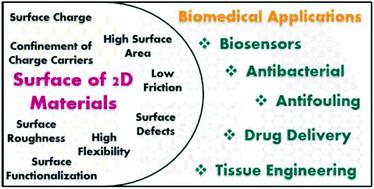Our official English website, www.x-mol.net, welcomes your
feedback! (Note: you will need to create a separate account there.)
Recent advancement in biomedical applications on the surface of two-dimensional materials: from biosensing to tissue engineering.
Nanoscale ( IF 5.8 ) Pub Date : 2020-09-22 , DOI: 10.1039/d0nr05287f Emily P Nguyen 1 , Cecilia de Carvalho Castro Silva 2 , Arben Merkoçi 3
Nanoscale ( IF 5.8 ) Pub Date : 2020-09-22 , DOI: 10.1039/d0nr05287f Emily P Nguyen 1 , Cecilia de Carvalho Castro Silva 2 , Arben Merkoçi 3
Affiliation

|
As biosensors and biomedical devices have become increasingly important to everyday diagnostics and monitoring, there are tremendous, and constant efforts towards developing and improving the reliability and versatility of such technology. As they offer high surface area-to-volume ratios and a diverse range of properties, from electronic to optical, two dimensional (2D) materials have proven to be very promising candidates for biological applications and technologies. Due to the dimensionality, 2D materials facilitate many interfacial phenomena that have shown to significantly improve the performance of biosensors, while recent advances in synthesis techniques and surface engineering methods also enable the realization of future biomedical devices. This short review aims to highlight the influence of 2D material surfaces and the properties that arise due to their 2D structure. Using recent (within the last few years) examples of biosensors and biomedical applications, we emphasize the important role of 2D materials in advancing developments and research for biosensing and healthcare.
中文翻译:

二维材料表面上生物医学应用的最新进展:从生物传感到组织工程。
随着生物传感器和生物医学设备在日常诊断和监控中变得越来越重要,因此人们为开发和改善这种技术的可靠性和多功能性付出了巨大而持续的努力。由于它们具有高的表面积/体积比以及从电子到光学的各种特性,因此二维(2D)材料已被证明是生物应用和技术的非常有希望的候选者。由于尺寸,二维材料促进了许多界面现象,这些现象已显示出显着改善生物传感器的性能,而合成技术和表面工程方法的最新进展也使未来生物医学设备的实现成为可能。本简短回顾旨在突出2D材料表面的影响以及由于其2D结构而产生的特性。通过使用最近(过去几年内)生物传感器和生物医学应用的实例,我们强调了2D材料在推动生物传感和医疗保健的发展和研究中的重要作用。
更新日期:2020-10-02
中文翻译:

二维材料表面上生物医学应用的最新进展:从生物传感到组织工程。
随着生物传感器和生物医学设备在日常诊断和监控中变得越来越重要,因此人们为开发和改善这种技术的可靠性和多功能性付出了巨大而持续的努力。由于它们具有高的表面积/体积比以及从电子到光学的各种特性,因此二维(2D)材料已被证明是生物应用和技术的非常有希望的候选者。由于尺寸,二维材料促进了许多界面现象,这些现象已显示出显着改善生物传感器的性能,而合成技术和表面工程方法的最新进展也使未来生物医学设备的实现成为可能。本简短回顾旨在突出2D材料表面的影响以及由于其2D结构而产生的特性。通过使用最近(过去几年内)生物传感器和生物医学应用的实例,我们强调了2D材料在推动生物传感和医疗保健的发展和研究中的重要作用。











































 京公网安备 11010802027423号
京公网安备 11010802027423号